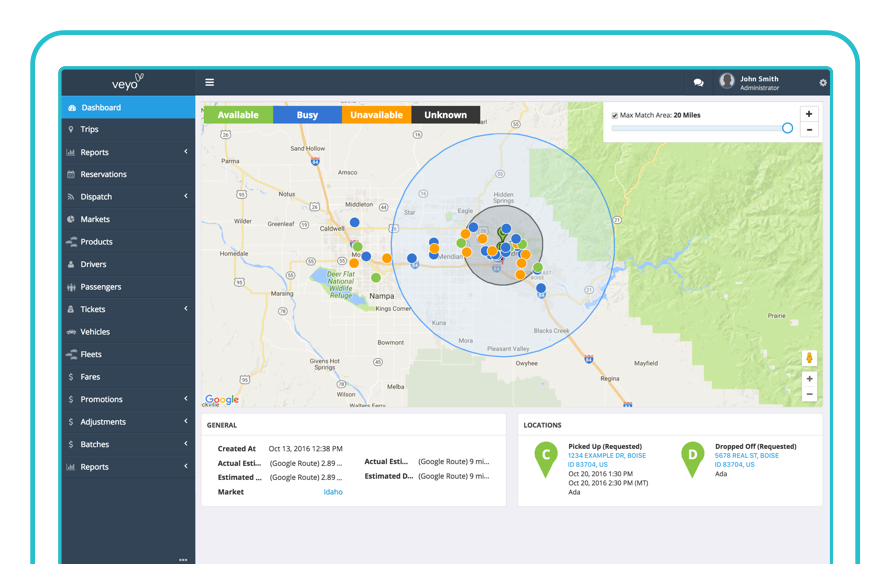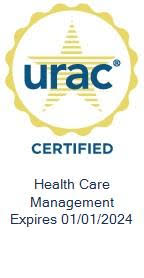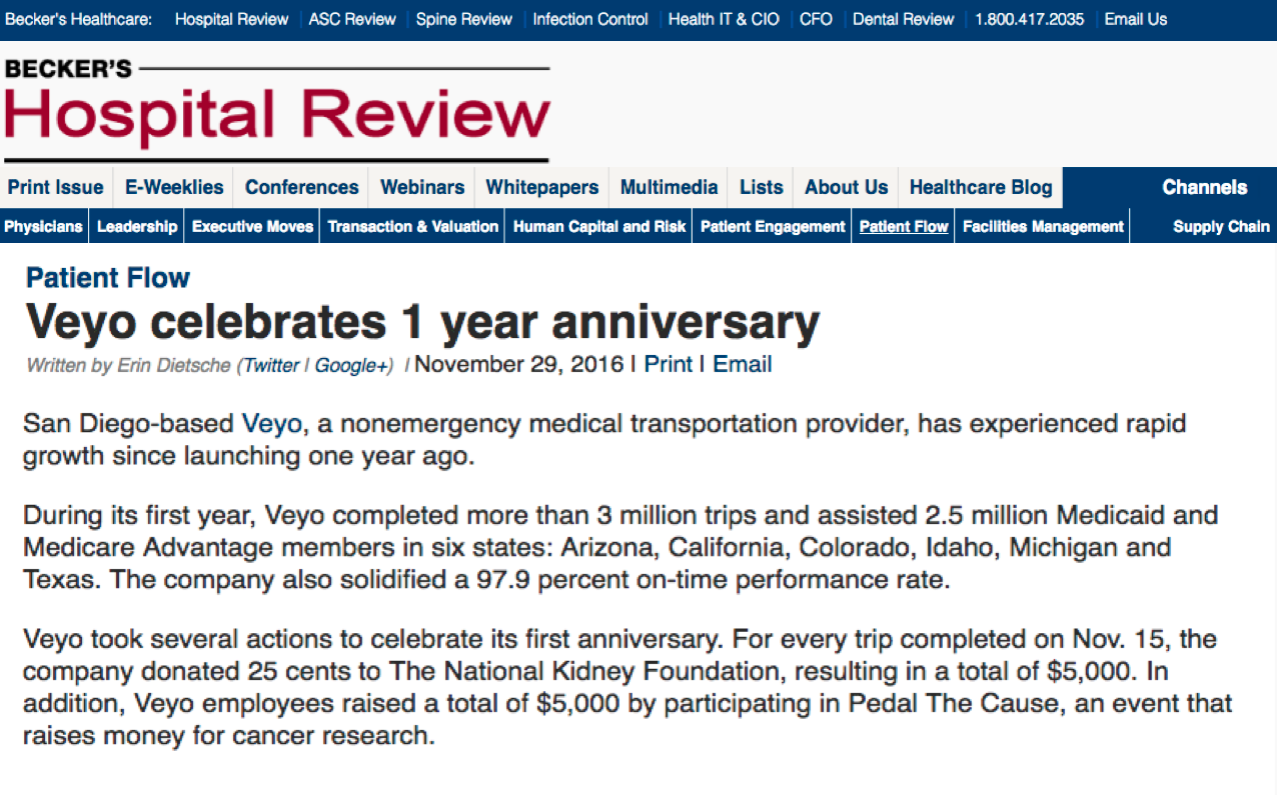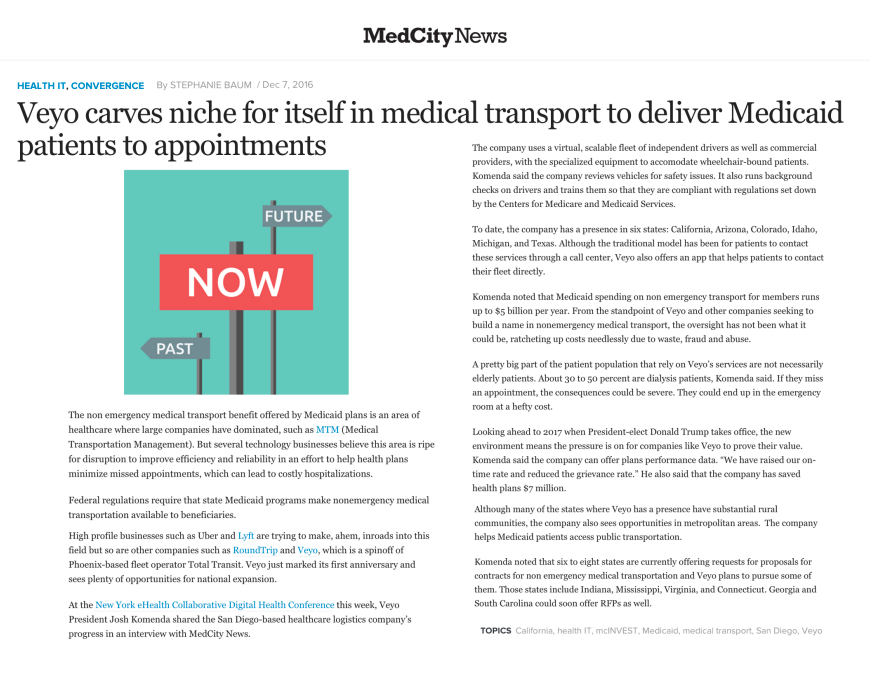How Veyo Stands Apart from Consumer-Based Transportation Network Companies
December 7, 2016
Beginning in 2011, the way consumers hailed a cab completely changed with the introduction of the rideshare model. Also known as Transportation Network Companies (TNCs), these consumer-focused models have disrupted the manner in which people like you and I get around cities and towns around the world. These TNCs also dramatically changed the quality and efficiency of consumer ground transportation services for the better.
What we have now seen occur, is that technology-centric companies are now able to:
- Build a highly-responsive network or fleet of private drivers and their private vehicles that allow these companies to grow and shrink supply within minutes, as needed.
- Use technology to provide transparency to end users for the first time.
- Analyze millions of data points in order to monitor performance, as well as predict supply and demand.
- Operate a capital-light model that can provide this superior performance at half the cost.
While these TNCs have proven powerful new models in the consumer world, Veyo was created to adapt these transportation network models for the complex needs of healthcare logistics, and most critically, Non-Emergency Medical Transportation (NEMT) beneficiaries.
In fact, Veyo has three critical advantages for the healthcare industry over traditional consumer models:
- Veyo brings innovation to the very broad needs of health plan memberships. Consumer TNCs are built to primarily serve individuals without any special needs—in urban geographies. Veyo’s Virtual Fleet™ Model employs a network of IDPs (Independent Driver-Providers) and third-party traditional, specialized NEMT fleets to meet the broad array of needs. From ambulatory, wheelchair, bariatric, stretcher, and other modes as required, our Virtual Fleet™ works together to seamlessly meet demand. The Virtual Fleet™’s IDP drivers are trained and credentialed according to Federal and State CMS requirements, including First Aid, CPR, HIPAA, ADA, patient sensitivity, and hand-to-hand service. The Virtual Fleet™ works in concert to serve members in big cities, small towns, and rural areas, and utilizes a variety of scheduling, routing, and matching techniques that are designed to get every member to their appointments on time. This model offers efficiency and high quality service—no matter where beneficiaries live or what their needs are.
- Veyo’s Platform is designed for the management of a state and/or health plan’s NEMT benefit. Government agencies and managed care organizations (MCOs) spend millions of dollars on a critical benefit that ensures their memberships can get to-and-from their appointments—safely and reliably. Veyo’s Platform is designed to bring next-generation tools to manage this NEMT benefit to ensure maximum effectiveness. Veyo employs call centers, booking portals, and member apps to verify eligibility, determine the most appropriate mode of transportation, and ensure the highest-quality access to care. We also pride our Platform on providing reliable, on-time performance reporting, trackability and transparency, while also employing sophisticated mechanisms to detect and prevent fraud, waste, and abuse. In addition, it can support customized eligibility criteria and steer members to alternative cost-saving modes such as mileage reimbursement and public transit where appropriate.
- Veyo was built, from the ground up, to be a healthcare ally by using data and technology to cut costs and improve outcomes. From basic requirements—such as: managing eligibility files, Private Health Information management, providing encounter data, to more advanced dashboards, reports, caseworker intervention alerts, and app campaigns—Veyo’s platform is at a state Department or health plans’ disposal to drive initiatives. The Platform will guide our customer’s understanding of their membership and help pilot new programs to drive better outcomes. More than just a basic transportation service, Veyo understands that it is part of a continuum of care, and uses its ability to interact with members and collect data to help plans make the most of their investment in NEMT.
Some traditional NEMT brokers have begun exploring partnerships with consumer TNCs in order to follow Veyo’s strategy for bringing TNC innovation into the NEMT realm. It’s important to note that it results in a solution that is not as efficient, coordinated, or suited to healthcare as Veyo’s—our vertically integrated model is far superior for a number of reasons.
- Veyo is directly connected to its own transportation network supply—that it controls. When a traditional broker partners with a consumer TNC, it includes an extra administrative middleman in the value chain, which is less economically efficient.
- What’s more, Veyo directly controls and oversees all aspects of its IDP network, meaning it can directly impact credentialing, training, background checks, messaging, etc.—ensuring that its network is optimized and trained specifically for its customers.
- In addition, Veyo can directly monitor, track, and manage its supply to match supply with demand and ensure it always has the right vehicles in the right places.
- Veyo can also directly control matching, routing, and scheduling tactics to make sure it solves transportation needs for all member needs, in all areas.
Our high-powered, data-oriented technology team and strategic focus allows us to reimagine many processes within the broker’s function, introduce new automation and efficiency, and provide new NEMT-specific tools and data insights for plans, agencies, and their members.
Josh Komenda
Josh is the President of Veyo. Before launching Veyo, he was president and co-founder of 2pointb and GoFastCab (Acquired by Total Transit), the creator of one of the first mobile ordering solutions for the taxicab industry. On the weekends, you can find him checking out a new hip restaurant in town, sipping a craft beer from one of San Diego’s micro-brews, or on a bike ride up the 101 in North San Diego County.





